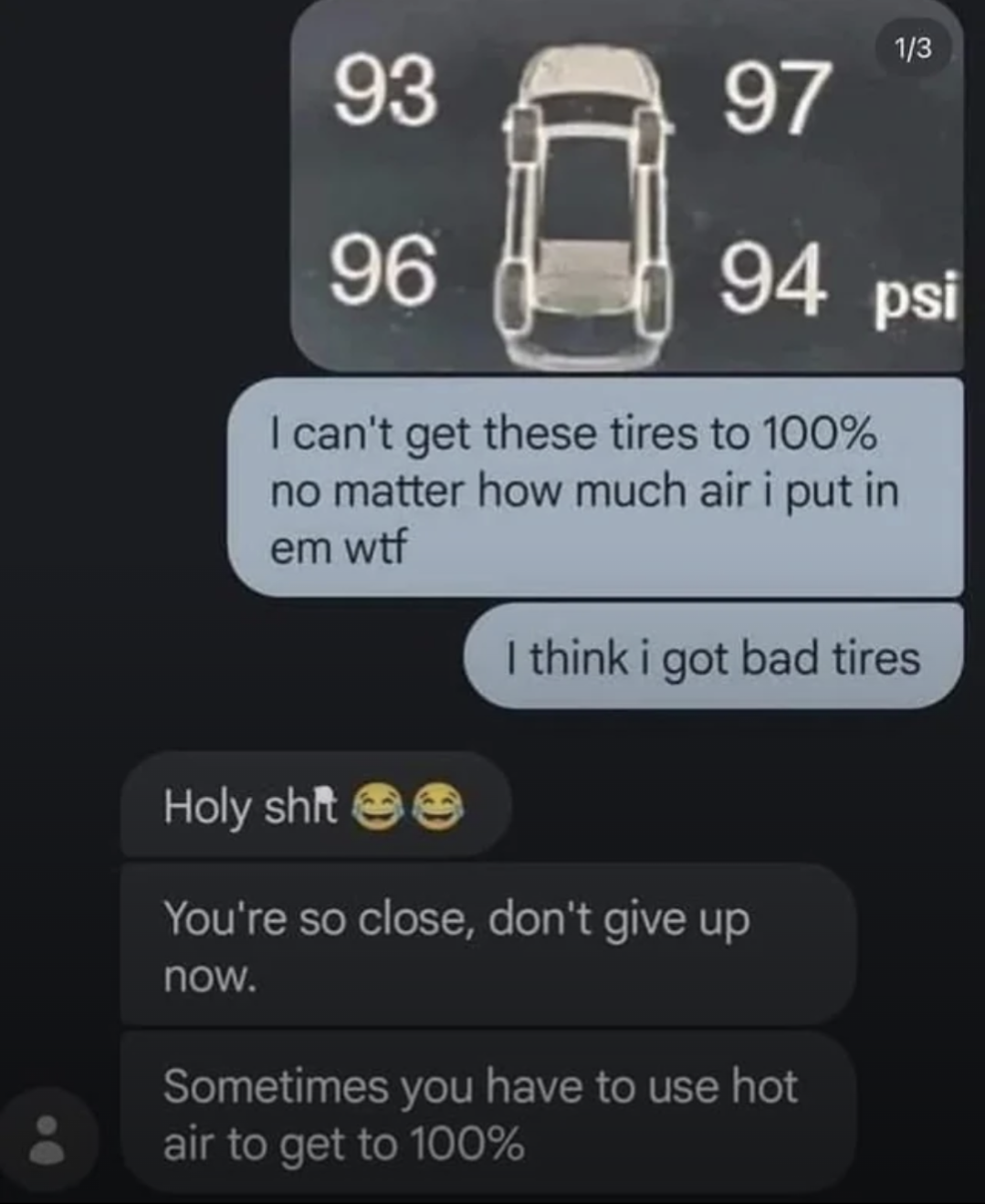this post was submitted on 20 Sep 2024
705 points (97.2% liked)
Funny: Home of the Haha
5742 readers
761 users here now
Welcome to /c/funny, a place for all your humorous and amusing content.
Looking for mods! Send an application to Stamets!
Our Rules:
-
Keep it civil. We're all people here. Be respectful to one another.
-
No sexism, racism, homophobia, transphobia or any other flavor of bigotry. I should not need to explain this one.
-
Try not to repost anything posted within the past month. Beyond that, go for it. Not everyone is on every site all the time.
Other Communities:
-
/c/TenForward@lemmy.world - Star Trek chat, memes and shitposts
-
/c/Memes@lemmy.world - General memes
founded 1 year ago
MODERATORS
you are viewing a single comment's thread
view the rest of the comments
view the rest of the comments

Road bicycles like the ones used in the Tour de France use pressures in the 120-140 psi range, but cars generally float around the 32 psi area.
Trucks often 60-100 though
Go to the truck stop and use the big rig hose. You'll get what you want 🤯
Yep, 60/80 PSI on my work truck, but the tires are 12-ply.
Probably less these days as it’s shown lower pressures and larger tires can improve performance.
Which type of performance? Surely not fuel economy/emissions?
Yes fuel economy. Energy expended per distance traveled or power needed to maintain a given speed. Just the fuel in this case is burned by your own body.
At world class levels, a few watts here and there will make a big difference by the end of a race.
Aah, gotcha. I had thought that
was in reference to this part at the end of the parent comment:
and I haven't seen anything to contradict all the previous literature on under-inflated automobile tires being worse for fuel economy.
Yeah it’s because the theory has been that high pressure decreases tire deformation and this is more efficient. This is where the wisdom of under inflated tires become less efficient. However lower pressure (like 80-90 psi) allows bicycle tires to absorb road imperfections and vibrations which actually ends up slightly more efficient. But if you go too low efficiency will be negatively affected.
Airplane tires actually have very high pressures to prevent hydroplaning, which is more important than ride quality or fuel efficiency for them.
Also planes have to land, and the impact on the tires is like hitting a pothole. You don't want the tires to touch rim at ~200 MPH on a many-million-dollar vehicle
Source?
All the studies I've read (and my experience) show that narrower tires and higher pressures improve economy. Less traction and less ride comfort are the tradeoffs, respectively.
GCN has a number of videos on this subject: https://youtu.be/jTZfrBVr5pQ?si=M5v6KP5ZZ9ZU5MXz
https://youtu.be/AK5KLvrzrb4?si=aMcYxYnWi9poZ8SA
And here is some technical data from SRAM: https://www.sram.com/globalassets/publicsites/cms-campaign-pages-not-story-pages/zipp/totalsystemeffeciency/pdf-downloads/tse-explained2.pdf
Basically new data includes vibration losses which get larger as pressure increases. There’s a sweet spot to balance between rolling resistance (which decreases with pressure) and vibration (which increases with pressure). So when you mention ride comfort as a trade off, it actually has a much larger effect than you might imagine.
Thanks for the videos and the PDF, but they are all bicycle related.
A car has a whole sophisticated subsystem dedicated for absorbing vibrations (the suspension), so I'm not sure the results can be applied there...
Oh I was only addressing this:
Fair enough
Suspension is great for smoothing out low frequency unevenness, but not so much for high frequencies, like something the size of gravel- a spring will ring like a bell.
That's why a suspension is much more than a spring.
Tops on my trucks is 44